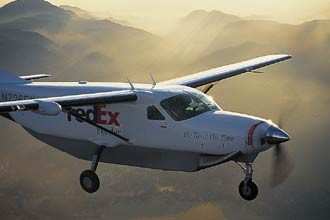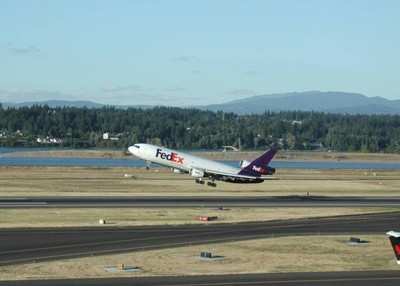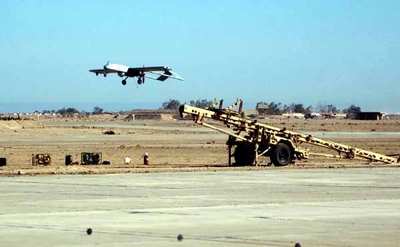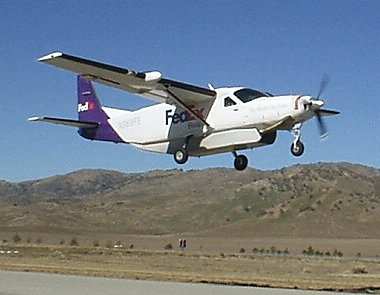Feed THIS To The Conspiracy Theorists
What in the world (or otherwise) hit Night Ship 282, a Cessna
208B Cargomaster (file photo of type, below) flying over southern
Alabama? In a report some observers say is unprecedented, the NTSB
admits the aircraft collided with something. But no one who's
investigated the case seems to know just what.

Thomas J. Preziose, a former NYPD pilot, flight instructor and
freight hauler, had just departed Mobile's Downtown Airport at
about 7:40 pm CDT on October 23rd, 2002. He was flying freight --
420 pounds of business documents -- to Montgomery (AL).
About five minutes into his flight, this exchange took place
between Preziose and Mobile Approach:
- 19:42:21 Night Ship 282: "Mobile departure
night ship ah two eighty two is with you at one thousand going to
two thousand."
- 19:42:25 ATC: "night ship two eighty two
mobile departure radar contact maintain three thousand turn right
join victor four fifty four please."
- 19:42:30 Night Ship 282: "Roger right turn
four fifty four."
- 19:44:25 ATC: "Night ship two eighty two
traffic at twelve o'clock of you and seven miles south bound heavy
DC ten at four thousand."
- 19:44:29 Night Ship 282: "Night ship two is
looking I'm IMC."
- 19:44:32 ATC: "Roger."
- 19:45:34 ATC: "Night ship two eighty two your
still IMC but that DC Ten is one o'clock and two miles south bound
at four thousand."
- 19:45:41 Night Ship 282: "Roger I got him
above me right now."
- Then, just seconds later:
- 19:45:57 Night Ship 282: "I needed to deviate,
I needed to deviate, I needed to deviate, I needed"
- End of Transmission
Investigators "don't know of any other accident that we have in
our files that states 'collision with an unknown object,'" said
NTSB Spokesman Keith Holloway, interviewed by the Mobile
Register.

What About The DC-10?
The picture is fuzzy, compounded by the fact that radar coverage
was limited because of an equipment problem. "The only radar data
available was a 'snap shot' taken from the equipment at Mobile
Regional Departure Control and NTAP data from Atlanta Center,"
according to the report. "The data shows that Night Ship 282, was
at 3000 feet, and the DC-10 was at 4000 feet and two airplanes
never crossed paths. According to the snap shot the DC-10 was to
the left of Night Ship 282. There were no known witnesses to the
accident."
The same FedEx DC-10 was given a walkaround inspection the next
day. There was no sign of damage.

What About The UAV?
Preziose was flying south of Mobile, not far from where the
military tests UAVs at both Tyndall AFB and Eglin AFB (FL). Could a
drone have wandered into his way?
"There's definitely no chance that that particular incident
involved one of our drones," said 1st Lt. Sage Park, at Tyndall's
53rd Wing, responding to the Register's questions. A spokesman from
Eglin said virtually the same thing.
But something definitely hit The Cargomaster head-on. The 208
was shattered, with mysterious red marks on several different parts
of the aircraft:
- Nose landing gear wheel (inside the tire)
- Top of the nose landing gear fork, aft side
- Top nose landing gear trunnion, forward side
Outer surface of the lower left side cowling near upper aft
corner
- Instrument panel support
- Lower aft side of cockpit cargo barrier
- Multiple places along the fuselage belly from Fuselage Station
(FS) 135 to FS 269, concentrated below the crew seats, at the left
cockpit door threshold, and main landing gear attachment area.
- Left lift strut fuselage fairing
- Left lift strut, aft side 2.5 feet outboard of the
fuselage
- Bottom trailing edge skin wing near Wing Station (WS) 75 (side
unconfirmed)
- Left wing dry bay panel (bottom of wing root between forward
and aft spars)
- Adjacent to right wing fuel filler
- Top of right elevator adjacent to outboard hinge
The red marks showed a "definite direction of transfer," but
varied in that direction, as if the Cargomaster and whatever hit it
changed aspect during the collision.
There were few clues found during the NTSB investigation to
indicate just what hit Night Ship 282. "There was a small piece of
what appeared to be black anodized aluminum," said the report,
"which was found embedded in the left wing dry bay panel at the
wing root between the spars. The origin of the metal remains
unknown; and is not believed to have come from the accident
airplane."

The impact of the collision all but vaporized the 208's (file
photo of type, above) engine. The NTSB report said, "Only the power
section and part of the gas generator was recovered. The constant
speed unit, fuel control unit and fuel pump were not recovered. The
compressor turbine stators were found bent in the direction of
rotor rotation. The first and second stage compressor rotors were
not recovered. The engine power section including the reduction
gearbox and gas generator was recovered intact. The compressor
intake case and remaining engine including the accessory gearbox
and accessories were not recovered. The engine displayed impact
damage at the 4 o'clock position on the exhaust case in the area of
the flange. The propeller shaft was intact and seized. The exhaust
duct displayed severe impact deformation with a significant portion
detached. The gas generator case displayed evidence of structural
compression and buckling. The compressor section was exposed as
recovered. The 1st and 2nd stage compressor rotors were not
recovered. The 3rd stage compressor rotor was missing all blades
except one which was found lodged in the 2nd stage stator. The
impeller was intact with nicks on the leading edge. The 1st and 2nd
stage compressor stators were intact and found bent in the
direction of rotor rotation. the 3rd stage stator was found intact
with minor damage to the leading edge. The 2nd and 3rd stage
spacers were found intact. The 1st stage spacer was missing. The
tie rods were fractured in the region of the 1st stage rotor. The
compressor inlet case and remaining engine was detached at the
flange attachment to the gas generator case. The compressor shroud
displayed circumferential rubbing due to compressor rotor blades
making radial contact. Examination of the power turbine as viewed
through the exhaust duct showed several blades fractured near the
tip. The blades remained attached to the power turbine disk.
Examination of the engine revealed that the damage noted was
consistent with the engine making power at time of the
accident."
"I've never seen a report like that," said Don Godwin, CEO of
Mid-Atlantic Freight, which owned the Cargomaster. "And it's very
troubling to have something like this happen and not know what
caused it. I know the family's upset, and understandably upset.
It's just a great thing that this kind of thing didn't happen to an
airliner with a bunch of people on it."
The NTSB sent bits of the aircraft, samples of the red marks and
other material -- including a piece of a military UAV such as those
flown from Tyndall and Eglin -- to Wright Patterson AFB (OH) for
microscopic analysis. The examination found "the red streaks on the
skin of the accident airplane was significantly different from the
other materials that were examined for comparison: the red cargo
bag, the red pitot cover, the paint on the airplane and the piece
from the unmanned aerial vehicle. The spectra that were obtained at
Wright Patterson Air Force base are effectively identical to those
obtained by the laboratory hired by the insurance company,
indicating that the red streaks on all the pieces of the airplane
are the same material. Without a specific candidate material for
comparison, it is not possible to identify the source of the red
streaks."

So What Was It?
Could the Cessna have been destroyed by wake turbulence caused
by the passing DC-10? Preziose's family apparently thinks so.
They've hired a lawyer to represent them in the case. But that
certainly wouldn't explain those mysterious red marks, nor the
force of an impact that the NTSB report says occurred in the
air.
If it wasn't a wandering UAV, then what? Some familiar with the
investigation suggest it might have been a drug smuggler.
"There is active drug smuggling in Alabama, yes, by air," said
Mobile's resident DEA agent, Sam Houston.
Back at Mid-Atlantic Freight, Godwin is skeptical. It's "very
hard to believe that in this United States, with terrorism being
what it is, that there's no record of any aircraft or object moving
in our space out there," he told the Register.
 ANN's Daily Aero-Term (10.12.25): High Speed Taxiway
ANN's Daily Aero-Term (10.12.25): High Speed Taxiway Aero-News: Quote of the Day (10.12.25)
Aero-News: Quote of the Day (10.12.25) Classic Aero-TV: PBY Catalina-From Wartime to Double Sunrises to the Long Sunset
Classic Aero-TV: PBY Catalina-From Wartime to Double Sunrises to the Long Sunset ANN's Daily Aero-Linx (10.12.25)
ANN's Daily Aero-Linx (10.12.25) Airborne 10.06.25: FAA Furloughs, Airshows Hit By Shutdown, Livestream Accident
Airborne 10.06.25: FAA Furloughs, Airshows Hit By Shutdown, Livestream Accident






